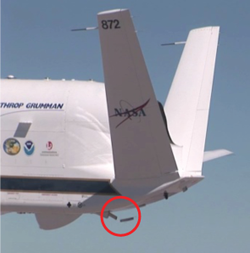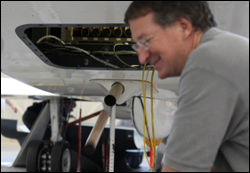
Global Hawk releasing a dropsonde |

Closer view of dropsonde launcher at the back of the Global Hawk |
NOAA to lead Winter Storms & Pacific Atmospheric Rivers (WISPAR) Experiment

The Global Hawk unmanned aircraft is capable of flying for up to 28 hours at altitudes from 60,000 – 65,000 ft. The NCAR Earth Observing Laboratory (EOL) and NOAA recently partnered in the development of a first-of-its-kind dropsonde system for the Global Hawk capable of deploying up to 89 sondes measuring vertical profiles of air temperature, pressure, humidity, and wind speed. Performance of the system was recently demonstrated during testing at the NASA Dryden Flight Research Center in California from January 19-25.
The long endurance of the Global Hawk aircraft coupled with the capability of deploying many sondes will enable unprecedented research into atmospheric river events and the forecasting of winter storms. Research led by ESRL PSD has shown that atmospheric rivers were present and a major contributor to recent flooding events along the west coast as well as beneficial increases in snowpack. Measurements will document conditions along the complete extent of an atmospheric river and its evolution as it approaches landfall. The operational Winter Storms Reconnaissance program led by NCEP uses the NOAA G-IV aircraft to observe regions found to have the greatest sensitivity in forecasts of severe weather. The Global Hawk will enable studying the impact of collecting measurements over a much wider extent of the sensitive regions than currently possible with manned aircraft. The experiment will further serve as a demonstration of capabilities applicable to future studies of the life cycle of tropical storms.